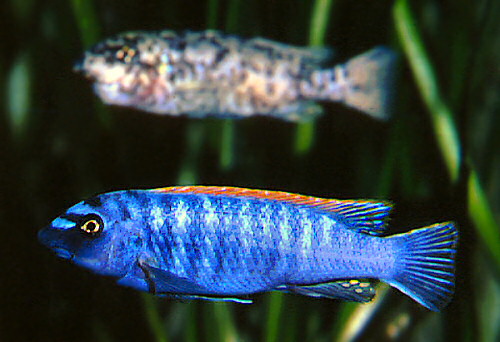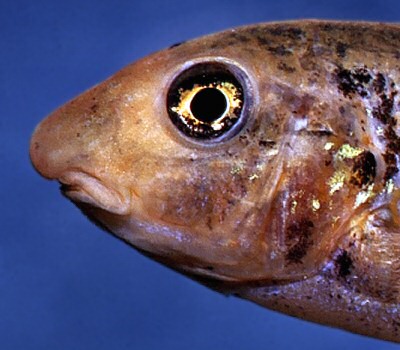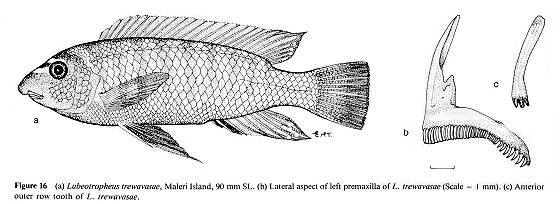

Labeotropheus trewavasae: A very rare blue-blotch male or "marmalade cat," photographed soon after it was collected from West Thumbi Island, Malawi, 4 July 1971 (photo © by M.K. Oliver). I consider this individual to be the most strikingly beautiful mbuna I have ever seen. A higher resolution photo of the posterior half is available below.
Labeotropheus trewavasae Fryer, 1956
by Michael K. Oliver, Ph.D.Above: This stunning fish is an adult male Labeotropheus trewavasae, but not just any male. It is a particularly striking example of the very rare
blue-blotch male morph — a so-called "marmalade cat." Photo © by M.K. Oliver. (More below)
I believe the person who first applied the name "marmalade cat" to blotched male cichlids was Trevor E. "Peter" Davies. Peter and his wife Henny were the principal aquarium fish
exporters in Malawi in the late 1960s and early '70s. Davies told me that he and his crew found only about one L. trewavasae "marmalade cat" per year, and asserted that they occurred only at the southern tip of Thumbi Island West (pers. comm. 4 July 1971). Individuals have since been found at a few additional, widely scattered localities, including Nkhata Bay (and transplanted from there to Likoma Island) and Pombo Rocks, Tanzania (Konings, 1995c: 130).

Above, lower fish: L. trewavasae male of the normal BB or black-barred blue morph. Its orange- red dorsal fin is characteristic of males from Thumbi Island West and a few other southern populations. An OB (orange-blotch) female can be seen in back, incubating eggs in her mouth. Photo © by M.K. Oliver, taken at the old Berlin Aquarium, 1968.Only males occur in this blue-blotched "marmalade cat" form, which seems to be a male equivalent of the far more common OB (orange blotch) morph seen in females. The frequency of OB female L. trewavasae varies from locality to locality, approaching 95% at some spots (Konings, 1995c). Rare orange (O morph) females also occur, but the most frequent morph of males is the standard BB or barred blue morph. All of these morphs are illustrated on this page. Even within a morph, much variation can be seen from one locality to another. The coloration of the dorsal fin is especially variable geographically.
English ecologist Geoffrey Fryer (1956b) recognized this species as distinct from L. fuelleborni during his doctoral research on Lake Nyasa (as it was then known). Fryer named this graceful cichlid L. trewavasae to honor Ethelwynn Trewavas, the taxonomist at the British Museum whose synopsis of Lake Malawi's cichlids a generation earlier (Trewavas, 1935) had considerably advanced the knowledge of their diversity. (The final -ae on the species name signifies that the honoree is female; -i indicates that a male is commemorated.)
Compared with L. fuelleborni, its sister species, L. trewavasae usually is noticeably more slender. This is the easiest way to distinguish the two species, both of which — as already noted — are quite variable in color. There are, however, some significant differences in the ecology of the two species as well.
Whereas populations of L. fuelleborni tend to be found in the upper 5 meters (16 feet) of the water, L. trewavasae has a greater depth range. According to Ribbink et al. (1983), "L. trewavasae favours large rocks, but also occurs in other habitats and is usually fairly evenly distributed from the surface waters down to about 20 m [65 feet]. It has been found to 34 m depth [112 feet]."
(Text continues below photos)
Ribbink and colleagues also summarize aspects of its territoriality and feeding ecology:
"Relative to its congener, L. trewavasae is weakly territorial. Males hold large, poorly defended territories among large rocks, normally favouring caves andcrevices formed by these rocks. They quite frequently vacate the territories to feed elsewhere. Females, juveniles and non-territorial males usually occur singly or in small groups.

Above: This close-up of the orange L. trewavasae (seen in its entirety above) gives a good view of the distinctive fleshy snout that overhangs the ventrally situated mouth. Photo © by M.K. Oliver.
"Feeding. At the island of Thumbi West L. trewavasae feeds principally from the under-surfaces of rocks ... and it is assumed that other populations also favour these surfaces. This species feeds on loose Aufwuchs, C1, C2, C3 [these are different kinds of firmly attached filamentous algae], benthic crustacea and plankton in varying proportions...." (Ribbink et al., 1983)
The possible role in feeding played by the fleshy "nose" in fishes of the genus Labeotropheus is discussed under L. fuelleborni.
In the aquarium, the aggressiveness of males can be best accommodated by keeping only one male together with several females in large quarters (at least 200 liters or 55 gallons), and by ensuring that there is adequate shelter for submissive individuals. It should be clear that this species is not a good choice for the beginning aquarist, nor for one who can provide only scant aquarium space.
As implied by the dietary observations above, these fishes require plenty of plant material for their primary food, but this can be supplemented occasionally with "plankton" in the form of live or frozen daphnia, fairy shrimp, brine shrimp, and bloodworms (mosquito larvae).
Reproduction is similar to that described for L. fuelleborni. Spawning accounts of L. trewavasae in captivity are available by Manuel Z. Galve at Cichlid Room Companion and by Craig Morfitt at Aquarticles.com.
At left: Labeotropheus trewavasae, photographed underwater at Thumbi Island West, Malawi. (See credit with drawing, below)
Below: A specimen of L. trewavasae (90 mm SL) from Maleri Island; (at right): left premaxilla (lateral view) and anterior outer row tooth of L. trewavasae (drawings by Elizabeth M. Tarr). Both the underwater photo at left above, from Plate 11f, and the drawing below from Fig. 16 of Ribbink et al. (1983) are reproduced here by permission of the Zoological Society of Southern Africa.


| Last Update: 7 December 2017
Web Author: M. K. Oliver, Ph.D. Copyright © 1997-2021 by M. K. Oliver, Ph.D. - ALL RIGHTS RESERVED |